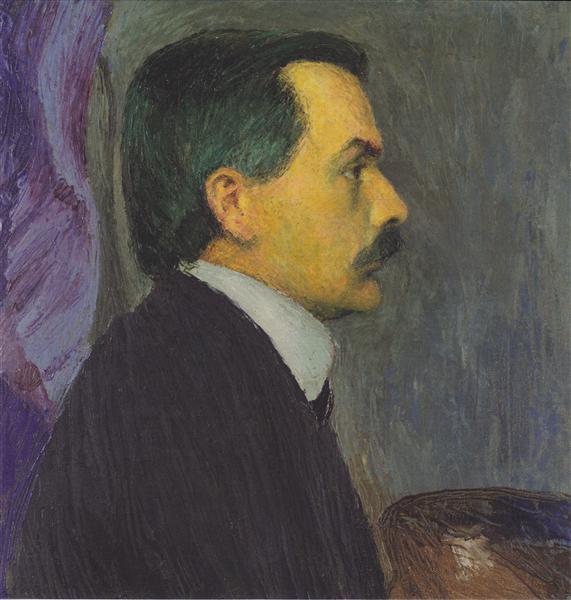Description
Koloman Moser, a prominent representative of the Vienna Secession Movement and collaborator of the famous artistic design movement, the Wiener Werkstätte, presents in its self -portrait of 1910 a unique exploration of identity and self -expression. This self -portrait, which reflects not only the artist's technical virtuosity, but also its ability to convey the psychology of the human being, is a work that invites the viewer to a deep contemplation of the sense of individuality.
The composition of the painting is remarkably elegant and balanced. Moser portrays himself in the foreground, which suggests an intimate connection with whom he observes. The figure is presented with a background in dark tones, highlighting its face, which, although it does not occur idealized, it does emerge as a focal point that captures attention. The artist's gaze is directed towards the viewer, establishing a visual dialogue that invites reflection on the interaction between the artist and his audience.
A relevant aspect of this work is the use of color. Moser uses a palette rich in terrible tones, which is complemented with touches of light that evoke the warmth of their skin. This chromatic choice not only brings depth to the figure, but also evokes a sense of warmth and affinity. The representation of hair, in a dark and textured tone, adds to the authenticity of the image and highlights the artist's technical skills in the representation of various materials.
As for the pictorial technique, Moser shows his mastery in the use of light and shadow, creating a three -dimensionality that enriches the surface of the canvas. Through safe and deliberate strokes, it achieves a texture that feels both soft and vibrant. This domain in the technique becomes a vehicle to transmit not only the physical appearance, but also a sense of the character and emotion of the portrayed.
Although other characters do not appear in self -portrait, Moser's presence is strong enough to fill the space. In this sense, the self -portrait becomes a mirror that reflects its own concerns and thoughts, making the work a personal document that transcends the merely visual. Moser, Figures in the Text World, accounts for its day to day, as well as its artistic context, influenced by Vienna's rich cultural life in the first part of the twentieth century.
It is important to note that Koloman Moser is not only remembered for her paintings, but also for its contribution to graphic design, ornamentation and architecture, which places it as a multifaceted figure within the art world. This self -portrait can be interpreted as a manifestation of its constant search to merge various artistic disciplines under an integral vision.
In conclusion, the self -portrait of 1910 is a masterpiece that encapsulates both Koloman Moser's identity and his deep understanding of human form and expression. The artist's ability to combine technique, color and emotionality on a single canvas invites viewers to an introspective connection with art and the artist, turning this piece into a milestone within the history of the Austrian and European art of the twentieth century.
KUADROS ©, a famous paint on your wall.
Hand-made oil painting reproductions, with the quality of professional artists and the distinctive seal of KUADROS ©.
Art reproduction service with satisfaction guarantee. If you are not completely satisfied with the replica of your painting, we refund your money 100%.

